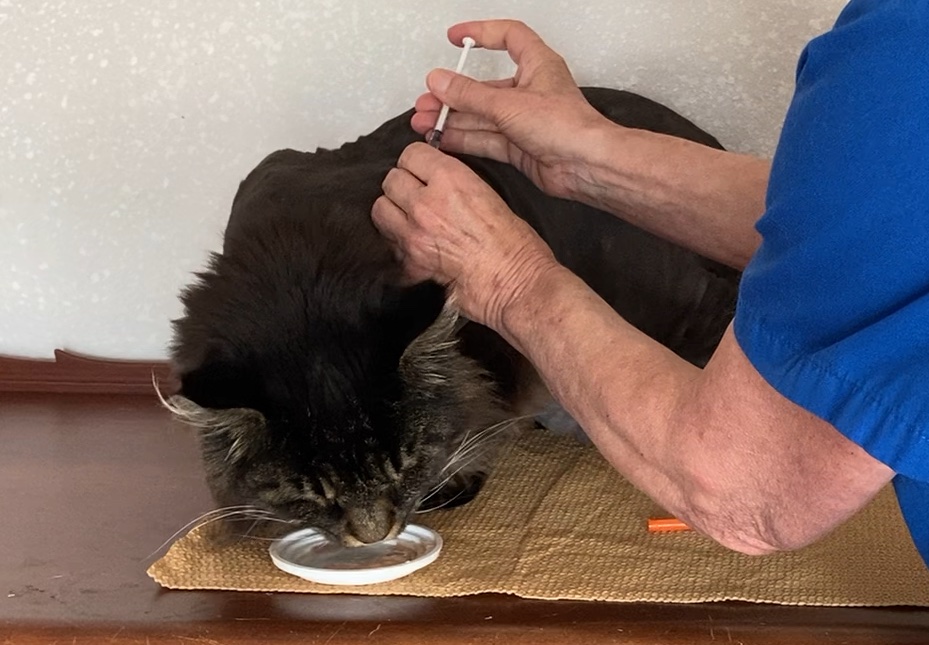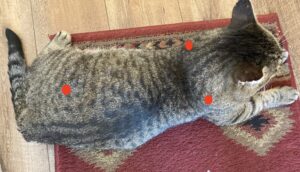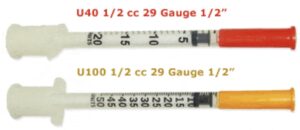
Diabetes is a condition where there is persistently high levels of glucose in the blood and urine. In healthy cats, insulin, a hormone produced by the beta cells in the pancreas, signals the cells in the body to take up glucose, reducing the glucose in the blood and urine. Diabetic cats are similar to human Type 2 diabetics – they are insulin resistant and have beta cells that are not functioning normally. What treatments are available for these cats?
treating diabetes in cats
One way to treat diabetes in cats is to supplement the insulin the cat is still producing with twice daily injections of insulin. There is not a commercially available feline insulin. Fortunately, production of anti-insulin antibodies does not appear to be a significant problem in cats and we can turn to the synthetic insulins made for the human market or a product derived from pig insulin, developed for dogs (Reference 1).
Practitioners typically reach for the longer-acting insulins listed below to manage feline diabetics (Reference 1)
- Glargine (brands:Lantus, Basaglar) is given twice daily. It is available in a 100 Units (U)/ml solution. It does not need to mixed before use and should be clear, not cloudy.
- Protamine Zinc Insulin (PZI) is also given twice daily. It comes in a 40 Units (U)/ml suspension which should be rolled or inverted gently to suspend it before using.
Vetsulin is derived from porcine insulin and has a shorter duration of action compared to glargine and PZI. It is not as well tolerated by cats as glargine and PZI. It should be shaken prior to use and be uniformly white in color. It is available in a 40 Units U/ml suspension.
treating diabetes in cats with insulin
Insulin is given by syringe under the skin (subcutaneously) every 12 hours. It is best to stick to the every 12 hour schedule but if this is not possible, you can administer it within 2 hours before or 2 hours after the 12 hour mark. Skip the dose if you are out of this window (Reference 1).
Insulin Syringes
- U-100 syringes are used with Glargine insulin.
- U-40 syringes are used with PZI and Vetsulin.
- Syringes with 0.5” needles are recommended – shorter needles may not always go far enough through the skin.

Giving Insulin Injections
- The injection can be given in the loose skin near the shoulder blade or hip.
- Rotate injection sites to avoid build up of scar tissue and for better absorption of the drug.
- There are many good videos on giving subcutaneous injections. Take a look at the “Caring for your Diabetic Cat” video on the “Health Topics” page at Cornell Feline Health Center.

Try to make giving injections as pleasant as possible. Establish a routine. It can help to have dedicated place to give treatments, for example, a soft blanket on one side of the sofa. If there is a treat or food your cat likes, be sure to offer this during or after the injection.
Diet and the Diabetic Cat
Insulin resistance has been linked to obesity in cats. If your diabetic cat is obese, losing weight can help manage his diabetes and possibly reduce his insulin dose.
If your cat has lost weight due to diabetes, start insulin therapy before starting a weight loss program. Once your cat is stable and you have established your “diabetic” routine, implement your weight loss plan (Reference 2).
Plan for weight loss
- determine how many calories your cat is eating
- reduce current calories by 10-20%
- monitor weight and body condition score (BCS)
Diets for Diabetic Cats
- a high protein, low carbohydrate diet is recommended
- canned foods are recommended due to their higher water content and lower carbohydrate content
- many obese cats have low BCS in spite of excess body fat and high protein may be needed to maintain lean body mass
There are therapeutic diets targeted at treating diabetes in cats. Purina DM and Hill’s m/d feature high protein and low carbohydrates. If your cat does not care for high protein/low carb diets, consider a high protein, low fat, moderate fiber and moderate carbohydrate diet such as Hill’s w/d food, designed to address glucose balance as well as weight loss and urinary care.
For cats with concurrent diseases, you will have to choose which condition is better treated by diet. For example, if your cat has kidney disease and diabetes, it may be wise to feed a kidney diet and manage the diabetes by adjusting insulin dose or type of insulin.
treating diabetes in cats – “non-insulin” therapies
Recently, the FDA approved two drugs given orally for diabetic cats: Bexacat (12/2022) and Senvelgo (8/2023). Bexacat is a once daily tablet; Senvelgo is a liquid given once daily with food or directly into the cat’s mouth.
Both these drugs (SGLT2 inhibitors) work by blocking the reabsorption of glucose by the kidneys. Instead of being returned to the bloodstream, glucose is excreted in the urine, lowering blood sugar without insulin. High levels of blood glucose have been tied to beta cell dysfunction – SGLT2 inhibitors lower blood sugar and are thought to promote growth of new beta cells (Reference 3).
These drugs work best for treating diabetes in cats who have been recently diagnosed and have NOT had previous insulin treatment. At this time, Bexacat and Senvelgo are NOT recommended for cats…(Reference 4)
- 13 years or older
- with pancreatitis or a history of pancreatitis
- with kidney disease or other concurrent disease
- having suffered a condition known as ketoacidosis.
Candidates should be healthy, with the exception of being diabetic (Reference 4).
Treating diabetes in cats has traditionally focused on giving insulin injections and feeding a high protein, low carbohydrate diet. Experts recommend using the long-acting insulins for cats. The injections are given twice daily. Recently, new oral therapies have been made available that offer once-a-day dosing and the potential of regenerating pancreatic cells.
In the next post, we will look at how we can monitor insulin and non-insulin therapies to ensure our diabetic cats’ health and safety.
references
- ISFM Consensus Guidelines on the Practical Management of Diabetes Mellitus in Cats. Sparkes, A. (chairman), Journal of Feline Medicine and Surgery (2015) 17, 235-250
- Clark M, Hoenig M. Feline comorbidities: Pathophysiology and management of the obese diabetic cat. Journal of Feline Medicine and Surgery. 2021;23(7):639-648. doi:10.1177/1098612X211021540
- (Nakamura A. Effects of Sodium-Glucose Co-Transporter-2 Inhibitors on Pancreatic β-Cell Mass and Function. International Journal of Molecular Sciences. 2022; 23(9):5104. https://doi.org/10.3390/ijms23095104 )




1 thought on “Treating Diabetes in Cats – Insulin and Non-Insulin Therapies”